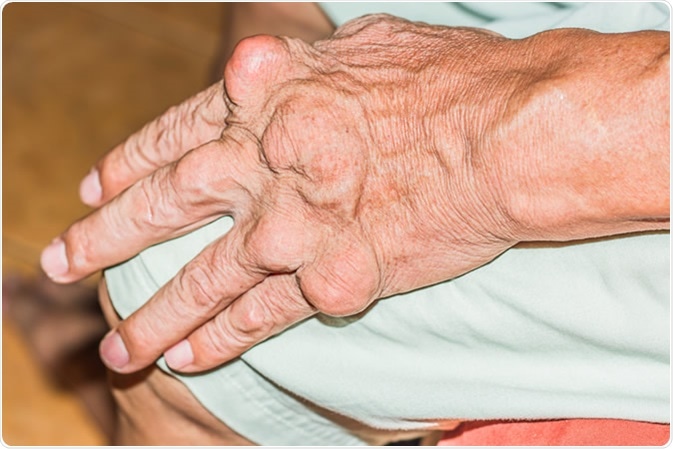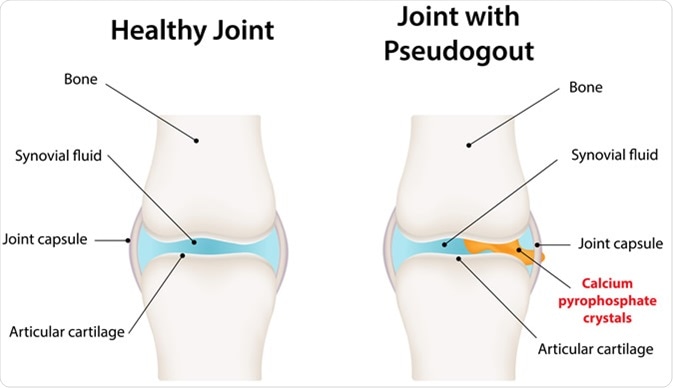Skip to:
Gout and pseudogout (also called calcium pyrophosphate deposition disease, or CPPD) are forms of arthritis which cause sudden and extremely painful attacks in one or more joints of the body.
Gout often affects the big toe first, along with the elbow, wrist, and finger joints. Pseudogout, on the other hand, generally affects larger joints such as the knee or wrist. During both conditions sharp crystals form in the joint causing irritation, swelling, redness, and pain. However, gout and pseudogout have very different caues.

Case of severe gout. Image Credit: Adul10 / Shutterstock
Causes of Gout
In gout, the crystals causing irritation are formed due to a build-up of uric acid in the blood. This can happen if you produce too much uric acid, or if your kidneys fail to filter out enough uric acid from your body.
High levels of uric acid in the blood can be a consequence of your genetics, and one in five people with gout also have a close family member with the condition. Dietary factors, such as eating red meat, seafood, consuming sugary drinks, or drinking alcohol, also increase your level of uric acid.
Many health-related factors that have been associated with the development of gout include: obesity, high cholesterol, heart disease, insulin resistance, kidney disease, and hyperthyroidism. Some medications can also increase your uric acid levels and risk of gout, including: diuretics, high blood pressure medication, blood thinners, chemotherapy medicines, and cyclosporine (a medication given to patients after an organ transplant).
Causes of Pseudogout
Pseudogout, in contrast, occurs when calcium pyrophosphate dihydrate crystals form in a joint. Many people will form these crystals throughout their life, including nearly half of those aged over 85 years. However, most of them do not develop pseudogout. It is unclear why only some people suffer with pseudogout, but research suggests it is not caused by diet or medication.

Pseudogout - image Credit: joshya / Shutterstock
Symptoms of pseudogout are more common in older individuals, in people who have a history of joint trauma, individuals with mineral imbalances (including too much calcium or iron in the blood, or too little magnesium), and in those with a family history of the condition. Pseudogout may also occur at the same time as other health conditions such as pneumonia, heart conditions, stroke, and thyroid problems.
Symptoms
The symptoms of both gout and pseudogout can start suddenly, and hot, red, swollen, and painful joints can limit your mobility. It may seem like the joint is infected, but it is generally not unless there are further medical complications. In gout, the crystals can form white bumps under the skin (called ‘tophi’), whereas the crystals are not visible in pseudogout.
Diagnosis
During your diagnosis, a full medical history will be taken to identify whether there are medications or other health problems which may be contributing to your symptoms. Your doctor may perform a physical examination, and may request that x-rays are taken of your affected joint. The calcium in the crystals of pseudogout can be seen on an x-ray, whereas uric acid is not visible.
The fluid from your joint may also be collected, and blood tests performed. This is to check for the presence of high levels of uric acid or calcium pyrophosphate dihydrate, whilst ruling out infection in the joint itself.
Treatment
Treatment aims to reduce levels of swelling, inflammation, redness, and pain in the affected joint. This is often achieved by use of anti-inflammatory medication (such as NSAID’s or colchicine). Splints or compression garments may be worn to reduce inflammation and minimise pain. Surgery may be recommended if there is any damage to tendons, ligaments, or joints.
When gout has been diagnosed, certain lifestyle changes may be recommended by a physician to prevent further attacks. This can include: losing weight via exercise regimes, adjusting your diet to avoid red meat or seafood, drinking less alcohol and sugary drinks, or adjusting your medications when possible. A medication called allopurinol may also be recommended to lower your levels of uric acid.
Further Reading
Last Updated: Dec 22, 2022